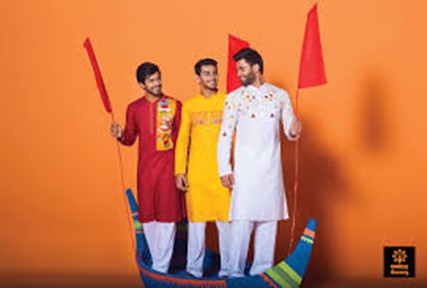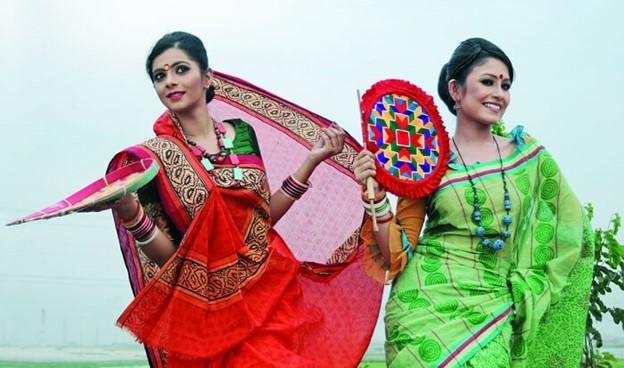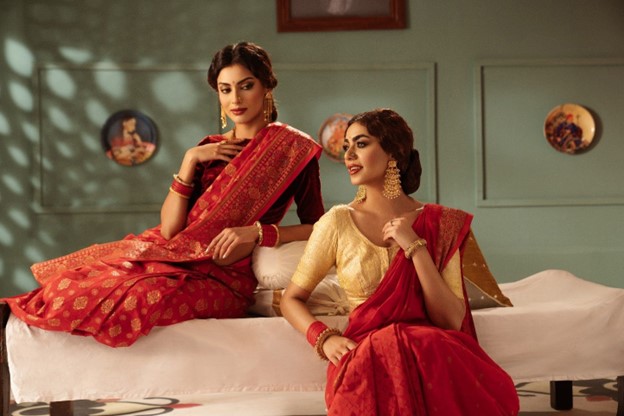The Apparel Digest Report Compilation
Pohela Boishakh, or Bengali New Year, is the most significant cultural festival celebrated with great enthusiasm and vibrant mood across Bangladesh. The festival is called ‘Noboborsho’ or ‘Borsho Boron Utshab’. It marks the first day of the Bengali first month, ‘Boishakh’ of the Bengali Solar Calendar. In Bangladesh, this festival is celebrated on 14 April which is a national holiday.
As per the folklore, the festival started during the reign of the great Mughal Ruler, Emperor Akbar (1556-1609). At that time, the economy of the country highly depended on agriculture. Moreover, the agricultural taxes were collected based on Arabic or Hijri year. Since the Hijri calendar was then lunar-based, it naturally did not match the agrarian solar year. It would certainly create a serious problem then. Because when it was time to collect taxes, the peasants would face extreme difficulties in paying the taxes out of season. Realizing this, Emperor Akbar changed the traditional tax collection system and formulated a new calendar so that taxpayers could pay their taxes smoothly in time. Indeed, it was a great initiative that Emperor Akbar took for the taxpayers then. Thus, Emperor Akbar introduced a new form of celebrating the Bengali New Year.

Pohela Boishakh is celebrated with a great deal of passion and joy all throughout Bangladesh as well as among Bengali populations all over the world. It is a celebration that hails the approach of spring. There is a significant deal of cultural importance associated with this important occasion, which reflects a sense of togetherness, cultural history, and regeneration. The attire that is worn at this event is an essential component of the celebrations, as it demonstrates the breadth of traditions and the variety of individual and collective identities for those who participate. Clothing that is colourful and finely crafted is worn by children, men, and women alike. This clothing reflects the variety of cultures and unique identities that exist. Women wear spectacular sarees, which are often made of luxurious materials and decorated with exquisite needlework or artistic motifs to symbolize the splendour and vigor of the season.

These sarees are worn by women. Pyjamas or dhotis are typically worn with the traditional Panjabi, which is a long blouse that is structured similarly to a tunic and is worn by men. In addition to the enormous variety of colours and designs that they are available in, some of them even have exquisite needlework or traditional motifs. Young people take part in the celebrations by donning their own unique adaptations of these traditional garments, which perfectly embody the elegance and joy of the occasion on Pohela Boishakh, the saree, which is the traditional garment worn by Bangladeshi ladies, is a symbol of grace and elegance. The production of sarees commonly involves the use of exquisite materials such as silk, cotton, or jamdani, all of which are known for their proficient weaving. These textiles are available in a broad variety of colours; nevertheless, for this joyful occasion, vibrant hues such as red, yellow, and white are particularly well-liked. The decorations of the sarees, which include floral motifs, paisleys, and traditional geometric designs, contribute to the further enhancement of the garments’ aesthetic appeal.

Putting the finishing touches on the traditional costume requires the use of a huge scarf or shawl known as an ornate. When it is placed over the head or shoulder, it lends an air of sophistication to the ensemble. When it comes to ornaments, there are a wide variety of options available; they can be plain and solid in colour, or they can be embellished with exquisite designs or skilled stitching. In addition to creating a fashion statement, they are a reminder of the need of humility and respect. The Pohela Boishakh ensemble would be lacking in its entirety if it were not for the jewellery, which is available in a wide range of materials and accessories. Jewellery made of gold or silver is widely worn by women. This includes rings, necklaces, bracelets, earrings, and other items of jewellery. Traditional to contemporary designs are shown in these patterns, which are based on motifs that are derived from history, culture, and the environment.

Panjabi, which are recognized by their knee-length cut and buttoned front, are the usual garments that Bangladeshi men adorn themselves with. Since it exudes beauty and elegance, this ensemble is completely suitable for the joyful events. There are a wide variety of Panjabis, ranging from those that are simple and unadorned to those that have intricately embroidered patterns. It is common for them to be made of comfortable fabrics such as silk or cotton, which ensures that the user will be comfortable in addition to looking fashionable. When it comes to colours, there is certainly a wide range of alternatives accessible. Bright colours such as red, yellow, and white are particularly popular during the Indian festival of Pohela Boishakh. This is because these hues are associated with joy, prosperity, and new beginnings. Intricate patterns and motifs, such as paisleys, geometric forms, and floral themes, typically look great when paired with these colours.
The significance of the clothing worn at Pohela Boishakh lies in the fact that it is more than just a representation of the fabric and design; it also demonstrates the cherished cultural past of Bangladesh. Traditional attire, such as the Sari for women and the Panjabi for men, is more than simply garments; it reflects the cultural significance, artistic expression, and historical significance that have been passed down through the years. The fabrics, colours, and patterns of these garments—such as the visually arresting red and white tones and the intricate floral designs are vital components of the rich cultural history that Bangladesh has.

On Pohela Boishakh, people show respect for their past by wearing in traditional garb. In doing so, they save and commemorate these treasured cultural relics. Additionally, the garments that are worn on this wonderful day symbolize the harmony and festivity that exists among everyone. When friends and family join to celebrate the new year, the vivid and traditional garments that everyone is wearing provide a striking display of unity that is sure to attract people’s attention.In addition to serving as a visual representation of similar practices and goals, the bright apparel also helps to symbolize the joy and celebration that is associated with the occasion. It serves as a reminder of the fundamental relationships that bind individuals from diverse origins together, which in turn helps to build a feeling of community and celebration
Pohela Boishakh’s clothing is significant not only for its aesthetic value but also for its role in the development of a robust feeling of identity and belonging. This not only encourages a sense of pride in one’s heritage but also makes it possible for individuals to freely express their cultural roots. In this approach, clothing becomes an effective technique for individuals to embrace and celebrate who they are within the context of the community. This, in turn, encourages a sense of togetherness and shared cultural pride on this momentous day.
Pohela Boishakh fashion has taken on a trendy twist, blending traditional elements with modern flair. Here’s what’s trending in clothing for the occasion:
- Bold Saree Styles:
One of the top picks for Boishakh includes cotton sarees adorned with vibrant floral prints. Also, modern saree draping techniques, like the dhoti saree or belt saree, bring a contemporary vibe to this classic attire.
- Printed Panjabis:
Men’s panjabis are getting a makeover with embroidery and eye-catching embellishments, making them a standout choice for the festivities.
- Fusion Fashion:
Mixing Bengali traditional wear with Western pieces, such as pairing a saree with a crop top or a panjabi with tailored trousers, is all the rage for a unique and trendy look.
- Vibrant Colors and Prints:
Bold hues and lively prints are making a comeback, adding a splash of excitement to Pohela Boishakh’s outfits and capturing the festive spirit.
- Sustainable Choices:
Many are choosing eco-friendly options like handloom or taant sarees and organic cotton panjabis, showing a growing appreciation for sustainable fashion while celebrating in style. Also, many choose salwar kameez, tunics, frocks, ghagra cholis, and T-shirts, casual shirts for their stylish and comfortable attire during the Boishakh festivities.
These fashion trends reflect the evolving tastes of Pohela Boishakh attire, blending tradition with a modern twist to create chic and culturally relevant outfits for today’s celebrants.
The act of dressing in a traditional manner is more than simply a question of personal preference; it is a symbol of our ancestry and identity. Keeping in touch with our roots, paying respect to our ancestors, and imparting knowledge to the next generation about our origins are all accomplished via the use of this approach. By adhering to traditional clothing, we can contribute to the preservation of our traditions and prevent them from being lost or forgotten in the face of modernization. The act of donning these garments is not only a demonstration of pride in one’s cultural variety but also an homage to the marvels of how people from different cultures can communicate with one another. An essential reason why it is crucial to wear traditional clothing with pride is that it serves as a representation of the vibrant mosaic of cultures that make up the variety of our globe as well as a rich tapestry of human history.
















